I lie in a cocoon, and even if it’s not made for my body but the artist’s, it’s comforting. The soundscape around me changes, becoming softer and more soothing. The cocoon—or the pupa—is surrounded by flesh-colored soft surfaces and fabrics, like an island. An island of strange creatures, an island of strange encounters.
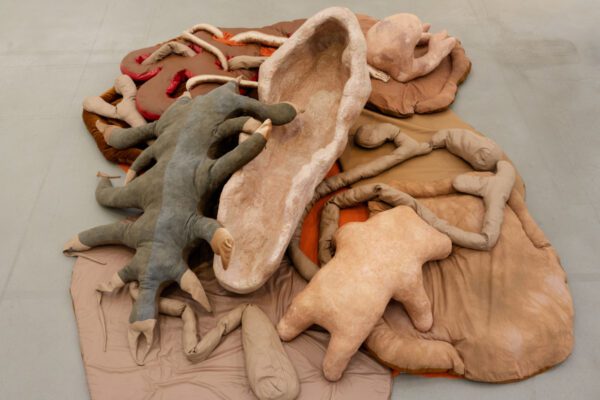
Morphogenesis—the generation of form—is a biological process in which an organism or a cell develops its shape. It is about processes, as is Kadri Liis Rääk’s Morphogenesis exhibition at the ARS Project Space, Tallinn, which explores ever-emerging things and transformations rather than presenting fixed ideas or end results.
Rääk’s exhibition leads visitors into its own entropy—a controlled chaos and a system of material objects, hard and soft elements, sculptures that can be almost recognized but are mostly strange and disturbing, and smells that defy expectations based on visual perception. The installations, composed of different elements, form islands that communicate with each other in a congruent open space, inviting the viewer to touch, listen and crawl into the works. The relationship to the works and the relationship between the works is constantly changing as the perspective changes and new details are discovered. The space becomes an intimate, theoretical process where things are constantly in a state of becoming.
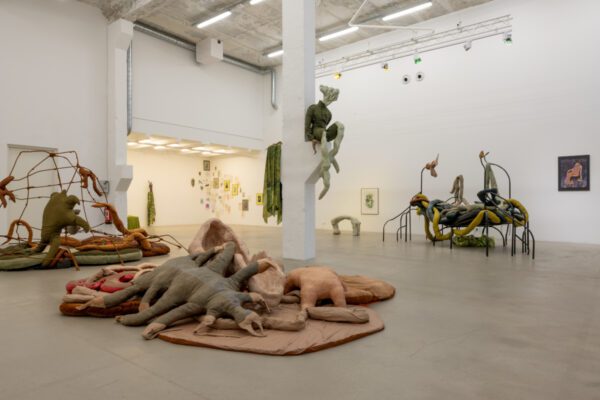
Kadri Liis Rääk is a multidisciplinary artist and researcher who focuses on creating immersive and tactile environments. In her practice she investigates how tactile interactions with artworks shift perceptions and foster dialogues extending beyond the visible. Rääk has participated in multiple exhibitions and residencies in Peru, Czech Republic, Belgium, Denmark, Iceland, and Estonia and Morphogenesis is a continuation of her previous projects, such as Grotto at The Factory in Iceland last year, which moved between spatial and mental aspects and explored the materiality of spaces, and Exopoiesis at the Hobusepea Gallery in Tallinn. Exopoiesis explored the exhibition as a system of relationships and an ecosystem in which the boundaries between internal and external, natural and artificial are blurred, producing new forms and narratives. At the same time, the exhibition is part of Rääk’s doctoral research, in which the spectator, with their experiences and the intimate relationships formed in the space, is the object of study.
Rääk’s current project gathers materials in movement, as anthropologist Tim Ingold might say (Ingold 2013). Literally—some works have been previously presented in slightly different forms or contexts and are now reborn in new space and time, while others are still searching for their place in the exhibition. Morphogenesis is a project of artistic research, articulated in multiple forms: sketches, notes, materials, experiments. But it is also an inhabitable space and a multisensory presentation. Installations resemble nests one can crawl into, cocoon-like; they invite visitors to stroke, caress, smell, and listen. Or they resemble morphing cells—organisms in motion disturbed by the visitors’ presence. The exhibition becomes a symbiotic planet, like scientist Lynn Margulis calls the process where the existence of objects depends on their relationships to each other and to their environment (Margulis 1998). Margulis’ idea of an evolutionary system suggests that, unlike Charles Darwin’s theory of evolution, progress is not only about competition, but collaboration too.
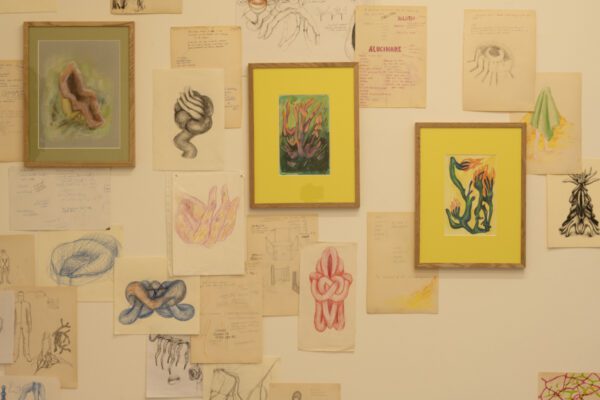
Sculptural elements communicate with immaterial ones, like smells and sounds, and the space becomes an atmospheric entity with many entrances, exits, and interpretations that shift over time. By challenging conventional norms of interaction and perception, the exhibition becomes a point of contact—an intersection of research, form-giving, spatial thinking, and embodied experience. It remains in a constant state of becoming, resisting solid perceptions in favor of fluid ones. Instead of permanence, the exhibition promotes ever-changing states of being.
The elements are both appealing and disturbing: fleshy pillows, bent bodies, the organic entangled with the artificial. The exhibition space becomes a site of strange encounters—something feminist author and scholar Sara Ahmed describes as bodies materializing in a “complex set of temporal and spatial relations to other bodies, including bodies that are recognised as familiar and friendly, and those that are considered strange” (Ahmed 2000, p.49).
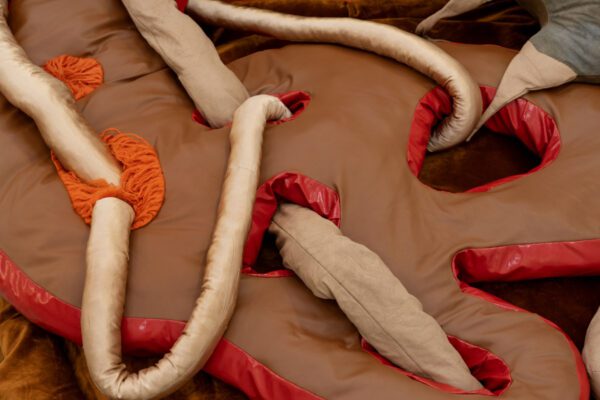
The objects are physical and embodied things in space, organised in a specific way, while the idea of the possibility of re-arranging them in different formations is visible. The sculptures and things in installations are also constellations of different materials that have been transformed into something else through a laborious process of handling the materials until the desired form and feel is achieved. There are two tiers of processes that are explored: the material processes, how things turn into other things and organisms that are combinations of different things, and how artistic practice is a process that allows these transformations to happen. The speculative exhibition draws us to the idea of spontaneous generation, living things coming out of non-living matter, life coming out of non-life.
Moving beyond the dichotomy of nature and culture, this approach invites us to observe objects as entangled in their environment. The exhibition applies diverse materials and techniques—from textiles to text, drawings, sculptures, sounds, and smells. Visitors are invited to use all their senses: to touch, smell, see, hear, and even crawl into artworks. This presentation is both accessible and methodological. Morphogenesis functions as “a poetic ecosystem, offering opportunities for embodied interaction,” as the artist writes. The project explores—in a multisensory way—metamorphoses of creative processes and how artists’ handwork shapes materials that transform and take form.
There is a fascinating randomness in how the exhibited objects relate to one another and to the visitors—and in how the visitor interprets the experience. If hay is seen, is the smell also hay—or something else? How quickly or slowly does the brain adjust to a strange encounter? How does the body dwell in the space?

The space itself is part of the installation: a site for tactile interaction and embodied encounter. Visitors are encouraged to touch the objects, which become affective agents—touching as they are touched. This system of mutual touch is like a language, reminiscent of Ursula K. Le Guin’s science fiction novel The Word for World is Forest (1972), where the forest people communicate mainly through touch. In the book, touch is part of language: patterned and codified, yet still modifiable. (Le Guin 2015.)
Touch occurs in-between inside and outside. When we touch something, we are also touched. In Strange Encounters Sara Ahmed writes how “subject and space leak into each other, inhabit each other” (Ahmed 2000, p. 89). This is what happens in the exhibition: I, as a visitor, become part of the work, leaking into the artworks while they leak into me. I become part of the research—an object in transition—already becoming something else as the artworks and processes change me. There is an urgent intimacy in how the works are presented, but also in how the visitor is explored—and perhaps exposed—as part of the constellation.
Still, participation is limited and controlled by the artist: the audience may move within the given frame but not alter it. This boundary creates safety and tangibility. The exhibition becomes a laboratory, where mice move through a maze while being observed — but cannot change the maze itself. The visitor becomes part of the design and dramaturgy. The uncanny objects are available yet incomprehensible, creating dissonance, opening queer moments that challenge perception in rewarding ways.
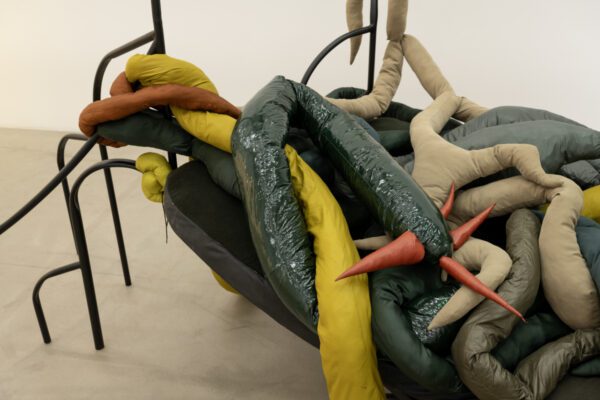
Rääk is interested in touch and how it is “one of the primordial senses that plays an integral role in understanding human experience and understanding of space” (Rääk 2024, p. 6). Her art and research create spaces for embodied and situated knowledge and understanding. The exhibition is an important statement about artistic research and its relational, interdisciplinary and process-driven nature. Morphogenesis shows how research can be an invitation to the other to participate in the middle, and this is a bold gesture that demonstrates how, rather than forcing artistic, process-led research into a scientific language, it is possible to trust the artistic form as an art-specific language in creating knowledge that can be spatial, tactile and embodied.
Text: Anna Jensen
Photos: Roman-Sten Tõnissoo
Kadri Liis Rääk: Morphogenesis
04.04.–20.04.2025
ARS Project Space, Tallinn
The text was written as part of a residency at the NART residence in Narva, kindly supported by the Finnish Cultural Foundation.
Literature
Ahmed, S. (2000) Strange Encounters: Embodied Others in Post-Coloniality. Routledge, Oxon, NY.
Ingold, T. (2013) Making: Anthropology, Archaeology, Art and Architecture. Routledge, New York.
Le Guin, U.K. (2015) The Word for World is Forest. Orion books.
Margulis, L. (1998) Symbiotic Planet. Basic Books.
Rääk, K.L. (2024) Touching the Unknown: Sensory Dissonance as a Means of Challenging Embodied Comfort Zones, Nordic Theatre Studies, 36(1), pp. 5–28. Available at: https://tidsskrift.dk/nts/article/view/152973/195826